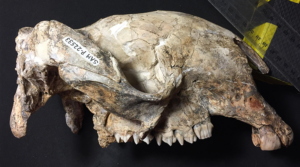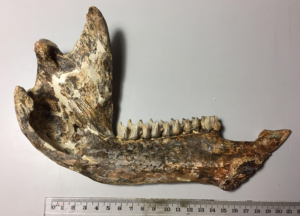Sthenurus stirlingi
Sthenurus stirlingi is the largest of the species of Sthenurus, a genus of short-faced kangaroos in the extinct subfamily Sthenurinae. This species was first described by Rod Wells and Dick Tedford in 1995.
Standing at least 2 m tall and weighing 150 kg, S. stirlingi was one of the largest kangaroos ever. The species inhabited the arid and semi-arid inland of Pleistocene Australia, where it browsed on tough leaves and branches from trees, shrubs, and bushes such as saltbush. This species, along with other large sthenurines, may have strode bipedally at low speeds instead of hopping.
Check the links below to view more of the holotype specimen.
Specimen number: SAMA P22533
Significance of specimen: Holotype
Geological age: Pleistocene
State/territory: South Australia
Locality/site: Lake Callabonna

